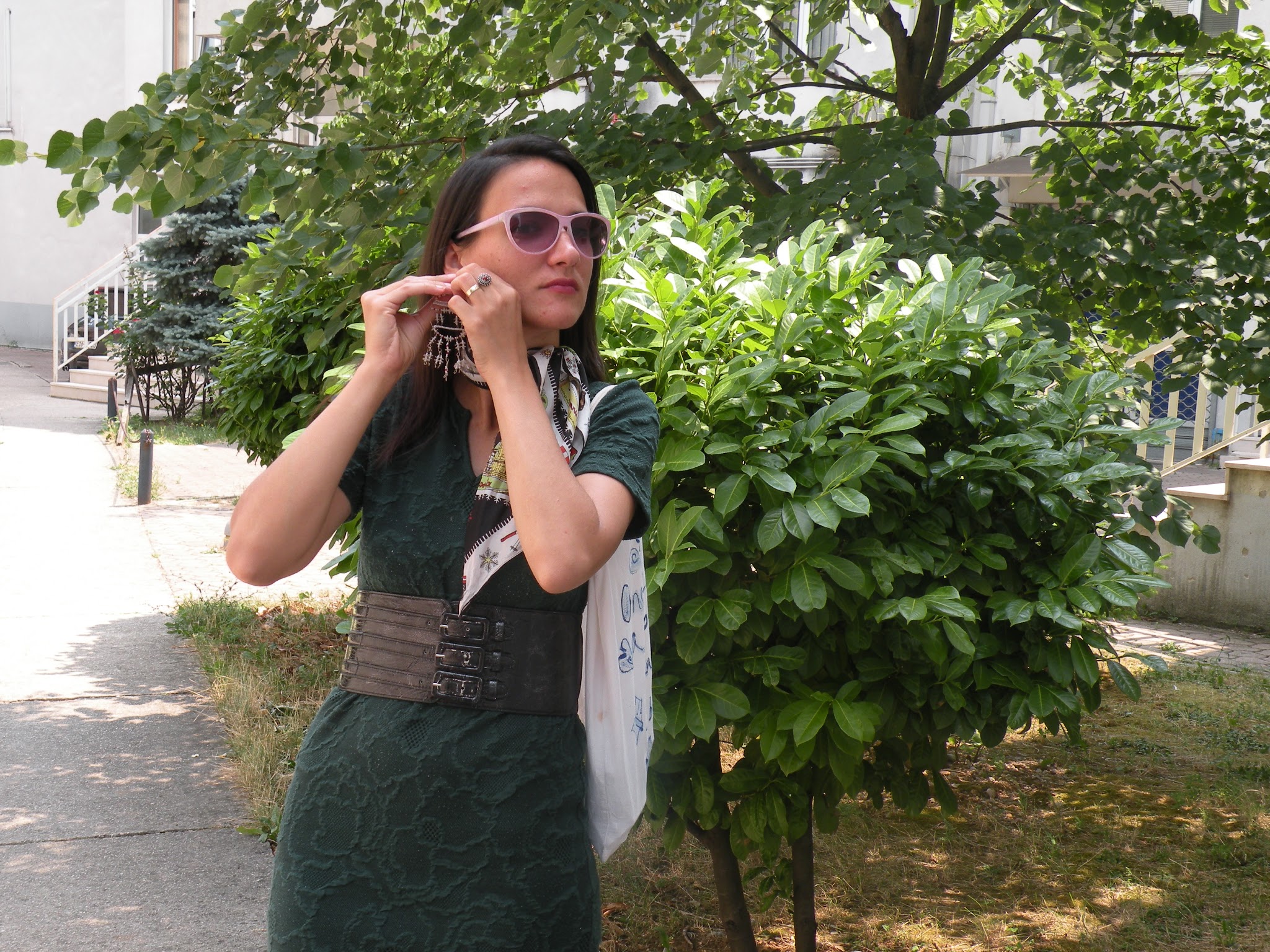VISIT MALTA WITH IVANA- HIKING TALES- SAINT JULIAN'S (PART FOUR)
Hello! In this post, I'll take you to Saint Julian's on Malta. Saint Julian's is a touristic town that is perhaps best described as a mix of traditional and new. The contrast is quite dramatic, you can literally see ancient ruins next to high skyscrapers. As you stroll Saint Julian's, you might even feel like you've wondered upon a construction site, as new skyscrapers seem to be rising continuously. Still, despite all of continuous construction and urban development, Saint Julian's has kept some of its old charm and remains a popular tourist site. Located only about ten kilometers north from Valletta, St. Julian's is a great place to visit. Here you'll see old traditional fishing boats located next to restaurants and night clubs.
I myself was taken to Saint Julian's by a friend. We strolled around and talked for hours. I really took this place in, you might say. One of the things in life I was blessed is a good memory. I can bring that evening to memory with amazing clearness. It was pretty much a perfect evening, too. Something I can look back on with a sense of gratefulness. In fact, a sense of gratefulness is what I feel when I think of my visit to Malta. Perhaps because that visit was what I needed in that moment. Perhaps because it was the first real vacation I took in a long time.
What do I remember from Saint Julian's? Well, it seemed so vibrant and full of life. The cafes were filled with laughter and chatter. You could hear different languages spoken. Malta is a rather small island and it's quite densely populated. I must admit that it didn't seem that densely populated when I was hiking Maltese cliffs and hills, but once I step foot in more urban areas, I could see it was densely populated indeed. It's a rather vibrant island! While in many ways it's a typical Mediterranean touristic destination, Malta has still managed to preserve its uniqueness. There's a lot to see and enjoy there!

ADMIRING TRADITIONAL MALTESE FISHING BOATS
My friend took a photograph of me next to one of famous Maltese fishing boats. I knew we had gorgeous traditional boats in Croatia (and we do!), but these Maltese boats are just as amazing. Painted with vibrant colours, they are little works of art. They even have eyes painted on them! I did some reseach and apparently those eyes are for protection. These boats are as beautiful as portrayed on postcards and touristic brochures.
MY CHILDHOOD IN A TRADITIONAL FISHING BOATS
I spend much of my childhood in a traditional fishing boat. If anyone will appreciate the beauty of a wooden boat, it's me. I often paint paintings of boats, too.
MALTESE TRADITIONAL FISHING BOATS ARE CALLED LUZZU
Traditional wooden boats may be considered as an essential aspect of Maltese culture, especially that related to maritime activities in the harbour areas and fishing villages. Maltese boats are known for their unique colour scheme and the eye of Osiris certainly being one of the most striking Maltese cultural heritage assets that serve also as a tourist attraction. This scheme is thus earmarked to assist boat owners to preserve and maintain their traditional wooden boats, namely the well-known luzzu, kajjik, firilla, frejgatina, dgħajsa tal-pass and dgħajsa tal-Latini.
CITED FROM https://culture.gov.mt/traditional-boats-preservation-scheme/
CITED FROM VISIT MALTA
St. Julian’s is now a major residential and tourist centre, and home to some of Malta’s newest hotels.
It is now an extension of Sliema although it started life as a small fishing port based on Spinola and Balluta Bays. St. Julian’s merges with Paceville, Malta’s main nightlife centre where there are clubs, casinos and numerous restaurants, cafes and bars.
Picturesque Spinola Bay is still used by fishermen whose traditional boats are housed just below the restaurants. The bay is particularly attractive at night and as a venue for open-air dining. The elegant Spinola Palace, built in 1658 by an Italian knight, Giovanni Spinola, is the landmark historic building on the bay.
While I was doing research about Saint Julien's, I came across a lovely blog about Malta written by Laura. She recommend visiting St. Julien's for a number of reasons, all of which, I can attest to. It really is a lovely place. Anyway, visit her blog if you want an insider's look into Malta.
WHEN YOU HEAR FAMILIAR VOICES ON MALTA
I took a photograph of this restaurant because my friend told me it was actually own by Croats. There are a lot of Croat expats on Malta. Not just Croats, but people from other Slavic Countries. I mean Malta is pretty multicultural. There are many expats living there. You can find people from all over the world on Malta. English is the language you'll hear most often, apart from Maltese, but you can really hear a lot of different languages while you're there.
SAINT JULIAN IS ALSO KNOWN FOR ITS DINING CULTURE, BARS AND NIGHT LIFE
To be honest, I didn't really experience much of Malta's night life, but apparently Saint Julian's the place to be. I did go out for drinks there once, if I recall well. Not that night, though. It was after seeing the new Batman movie in a theatre. But you couldn't say I was clubbing while I was there. Not much of a clubbing person! Still, one could feel the atmosphere was there and it's known as a party destination, so if that is what you're looking for, St Julien is as good a place as any other.
This lovely statue with birds also caught my eye. Isn't it just lovely?
SAINT JULIAN HAS A FLAG SIMILAR TO BELGIUM BECAUSE IT SAINT JULIAN COULD HAVE BEEN BELGIAN
The town is named after its patron saint; Saint Julian who is widely known as Julian the Hospitaller and Julian the Poor whereby he is the patron saint of hunters.[3] Before the reform to the Calendar of Saints, the memorial to St Julian was on 27 January. Nowadays, it is celebrated on 12 February,[4] although in Malta an additional feast, in the spirit of the many summer feasts around the island, is celebrated on the last Sunday of August.[5]
TRADITIONAL FEASTS THAT TAKE PLACE IN SAINT JULIAN
A very particular competition connected with the town's feast is known as ġostra.[6] This traditional competitive feat involves participants climbing and running as far as possible along a sloping greased pole which is suspended above the sea. The winner is the person to grab one of three flags dangling from the edge, each flag representing a certain prize.[7]
Another tradition connected with the feast of this locality is 'Musketterija. Starting in 1982, this tradition sees Hunters firing blank cartridges filled with black powder from the roof of the parish church as the statue of the patron saint is brought out of the church. Many say this tradition is in line with the history of the locality which used to be hunting grounds for the Knights of Malta.[7]
The town is located on Malta's east coast, north of Valletta and the neighbouing town of Sliema. It is subdivided into informal districts which are Paceville, Ta' Ġiorni, Tal-Għoqod and St Andrew's, as well as the regions surrounding St George's Bay, Spinola Bay, Balluta Bay, and Il-Qaliet cliffs.
THE PARISH CHURCH
The earliest documentary evidence of this church is of the pastoral visit of Bishop Tommaso Gargallo of 1601, which he says was built in 1580 and was dedicated to Saint Julian. In 1736, when Monsignor Alpheran de Bussan re-visited Saint Julian's, he noted that the locality was already known as Portus Sancti Juliani, meaning "St Julian's port". In 1854, the 600 or so residents of Saint Julian's appealed to the church authority, in order to make it a parish. The chapter at Birkirkara protested strongly against such an application and consequently the application was denied; but it was granted at reapplication in 1891. Dun Guzepp Scerri became the first parish priest.[9]
The parish church was designed by Maltese architect Arturo Zammit and its first stone was laid in 1961. It was used for the first time in 1968 when it was still not fully built.[10] The church welcomed Pope John Paul II on his first visit to Malta on 27 May 1990.[11]
The Millenium Chapel designed by Maltese architect Richard England was inaugurated in 2000. It houses a meditation garden inaugurated in May 2018 as a refuge for contemplation and tranquility right in the heart of the entertainment Zone of Paceville.[12] Built on the initiative and run by Fr Hilary Tagliaferro, this church is run by Augustinian clergy through the Millenium Chapel Foundation.[13]
Until the nineteenth and early twentieth centuries, St. Julians was a very peaceful coastal town known for its Latin architecture such as the Spinola Palace and greenery surrounding it. Moreover, Spinola Bay was characterized by its fishermen and farmers dwelling the countryside.
The building of Spinola Palace, coming as it does in 1688, is to be regarded as the stepping stone for the coastal reclamation of San Ġiljan. The palace, together with the surrounding gardens, was built by Fra Paolo Raffaele Spinola for the public entertainment as stated in the inscription above the portico. The palace was enlarged in 1733 through the efforts of Fra Giovanni Battista Spínola, successor to his uncle as rector and Curator of the Abbazia.[15] During the French occupation of these islands in 1798, St Julians was the first town in Malta to be conquered by French troops led by General Claude Henri Vaubois who led the French forces into Spinola Bay.
NOTABLE PLACES TO VISIT
cited from https://www.visitmalta.com/en/attraction/parish-church-our-lady-mt-carmel/
Balluta Bay is a bay on the northeast coast of Malta within St. Julian's. It is a popular recreation spot used for swimming, diving, and water sports, with a triangular pjazza surrounded by cafés and shaded by Judas trees. Its skyline is dominated by the neo-gothic Carmelite Parish Church and the art nouveau Balluta Buildings, which are apartment buildings on the eastern shore, as well as a cluster of terraced townhouses in the local variant of Georgian-style architecture. The south shore of Balluta Bay features Le Méridien St. Julian's Hotel, built on the grounds surrounding the 18th-century Villa Cassar Torregiani.*
*Cited from wikipedia
THIS IS, HANDS DOWN, ONE OF THE MOST BEAUTIFUL CHURCHES I HAVE EVER SEEN!
Sometimes simply known as the Carmelite Church, or the Balluta Parish Church, this is a neo-gothic Roman Catholic parish church located in Balluta Bay, in St Julians.
The present church dates from the early to mid-20th century. The original Carmelite church was a small neo-gothic chapel which had been built in 1859, based on plans drawn up by Emanuele Luigi Galizia. Later, it was handed over to the Carmelite friars, who rebuilt it in 1900, on plans by the architect Gustavo R. Vincenti. After Vincenti's death, Joseph M. Spiteri took over. It was then further enlarged in 1958.
In 1974, the area surrounding the church was turned into a parish, separate from that of St Julian's, and this church was chosen to be its parish church. It was dedicated on 12 December 1984.
ROMAN BATHS THAT ARE ACTUALLY VICTORIAN
Another thing that really fascinated me about Saint Julian are these Roman baths. People still bathe in them! How amazing is that?
After doing some research, I learned that these baths actually date back to Victorian not Roman times. They were made for rich English families. So, basically British aristocracy as opposed to ancient Romans. Still, they are an interesting sight!
Not much has been written on the history of the Maltese baths except for some sketchy recollections by folklorist Arthur Grima who in 1992 wrote a brief article on the journal l-Inwara. He recalls that up to the 1930s “whenever you see a woman at the sea you would have thought that she had fallen in the sea as she would have been fully clothed.”
The “rich” also used to have “baths” dug in the vicinity of their summer homes to ensure maximum privacy. This suggests that from its very inception sea-side culture was intertwined with the attempts of the rich to carve up private space on the public coastline.
The rock pools dug by bush hammers were constructed for this purpose: having a hole in each corner where a wooden pole was inserted serving as support for a blanket that covered the bathers. The blankets served two purposes: protection from the sun and prying eyes. But although screened from view “they still used to wear oversized swimming suits.” Two steps were also dug in the rocks to facilitate descent into the water while digging a narrow trench from which seawater could enter into the “bath” ensured water circulation. The baths were only three feet deep in a way that people who do not know how to swim could still enjoy the sea. In fact up to this day young children and those who have not yet learned how to swim often use baths.
Although the “baths”, as the rock pools were popularly known, belonged to the landed gentry, some were rented out to the public. In Rajt Malta Tinbidel Herbert Ganado recalls the Marsamxett baths known as “Tas-Sur Tankred”, being rented out on an hourly basis.
By the 1950 and 1960s the “baths” in vicinity of the Excelsior hotel in Marsamxett were still popular among children from Floriana and Valletta.
But by that time the baths were no longer covered and were mostly frequented because they offered a safer and more sheltered environment.
LOOK AT HOW HAPPY I WAS!
Thank you for reading and visiting!
You can also read about my other visits to Malta:
CHECK OUT MY OTHER VISITS TO MALTA



























Bello lugar, deseo visitarlo. Te mando un beso.
ReplyDeleteOh, so spectacular! Meeting the old with the new in Malta! Lovely sea with the fishing boats and a great history of the church. It looks like a fascinating place to visit! So great to see your tour and the wonderful write up too!
ReplyDeleteSuch lovely photos of the city! I love the part about the sea and what it has to offer. Thanks so much for the beautiful photos and the beauty of Malta!
ReplyDeleteThank you for such an interesting post and beautiful photos. I've never been to Malta.
ReplyDeleteSaint Julian's looks like a wonderful place to visit. I do love the juxtaposition of traditional and new.
ReplyDeleteHow interesting that its flag is similar to my country's! xxx
Wow you travelled to Malta, it's a beautiful island, very touristy! I also love fishing boats, having worked in a shipyard, of course the boats we built were much bigger! But that made me really admire all kinds of boats! You've made a perfect guide to St Julians! I like to see that contrast between the old and the modern in architecture!
ReplyDeleteWow! What a great post. You look so cool in front of the fishing boat. I'm embarrassed to admit I don't know where Malta, Valletta, etc. are located. Like too many Yanks my knowledge of the world is limited. You make us want to travel and see such lovely places!
ReplyDeleteBom dia, uma excelente quinta-feira, com muita paz e saúde. Obrigado pelos comentários sobre a Gruta do Maquiné. Espero que você goste da postagem de hoje. Espero conhecer outros países um dia.
ReplyDeleteChe carina Malta!
ReplyDeleteAnche io l'ho visitata diversi anni fa, ma era giugno ed era affollatisimo!!!
Quindi non sono riuscita ad apprezzarla quanto hai fatto tu e mi è sempre dispaiciuto un pò...
Hai fatto benissimo ad andarci in un periodo poco frequentato: questo sarebbe il primo consiglio che darei a chi volesse andare a Malta: è troppo piccola per contenere tutti i turisti che sbarcano!
Bellissima descrizione di tutti i posti che hai visitato, leggendo me li ricordavo man mano anche io, e bellissime foto!
Baci!
S
https://s-fashion-avenue.blogspot.com
As Always, fantastic post dear Ivana! Thank you for exciting journey 🫅
ReplyDeleteSaint Julian does look like a wonderful place to visit from your photos and descriptions. Vibrant and full of life indeed.
ReplyDelete